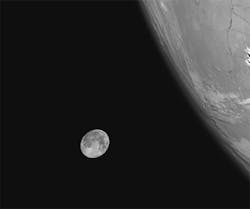Satellite imager captures perfect picture of a blue Moon
Europe's latest weather satellite got a glimpse of the Moon before it disappeared from view behind Earth on Friday last week.
An image taken by the Spinning Enhanced Visible and Infrared Imager (SEVIRI) instrument in the central compartment of the third Meteosat Second Generation (MSG-3) satellite shows the second full Moon of the month -- known as a 'blue' Moon -- just before it disappeared from the satellite’s sight behind the southern hemisphere.
Brazil's eastern coast along the South Atlantic Ocean is also visible in the image, with clouds forming over the water.
Launched on July 5, the third Meteosat Second Generation satellite is in a six-month commissioning phase by Eumetsat (Darmstadt,Germany), the European Organisation for Exploitation of Meteorological Satellites.
The European Space Agency (ESA) developed the satellite in close co-operation with Eumetsat, and was responsible for initial operations after launch. It was then handed over to Eumetsat on July 16.
The first satellite in the series, MSG-1 -- also known as Meteosat-8 -- was launched in 2002. MSG-2 followed three years later. Both have continued the legacy of the operational meteorological satellites that started with Meteosat-1 in 1977.
Related stories from Vision Systems Design that you might also find of interest.
1. Wide-angle camera captures sharper images of moon landing sites
A camera onboard NASA's Lunar Reconnaissance Orbiter (LRO) has captured the sharpest images ever taken from space of the Apollo 12, 14, and 17 landing sites on the moon.
2. Moon mapping produces high-resolution models on 100-m scale
The highest resolution near-global topographic map of the Moon ever created has been released by the Arizona State University (Phoenix, AZ, USA) team that oversees the imaging system on board NASA's Lunar Reconnaissance Orbiter (LRO).
3. LOLA finds ice in lunar crater
Data from the Lunar Orbiter Laser Altimeter (LOLA) on board NASA's Lunar Reconnaissance Orbiter (LRO) spacecraft indicates that ice may make up as much as 22 per cent of the surface material in a crater located on the south pole of the moon.
-- Dave Wilson, Senior Editor, Vision Systems Design
